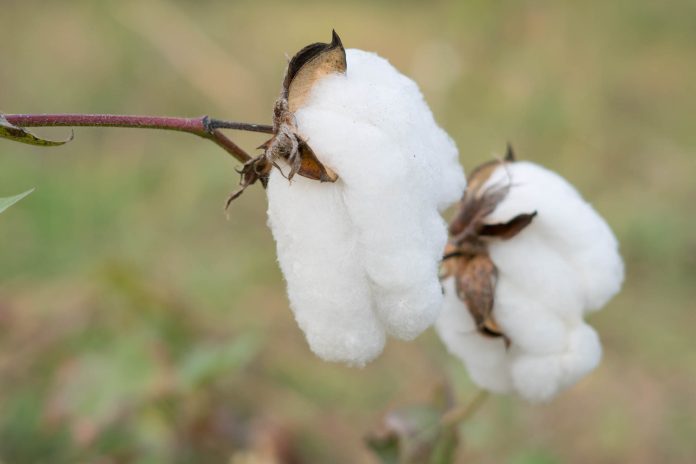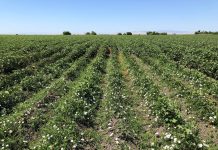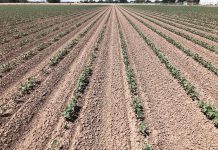This project covers two primary purposes: 1) Conduct germplasm screening trials of commercially-available cultivars plus evaluations of experimental cultivars seed companies submit to us for FOV resistance evaluations. In these evaluations, all entries in all University of CA variety trials (Acala/Upland, Upland Advanced Strains, Pima, Pima experimental cultivars, National Standards trials) are included, plus experimental entries submitted by seed company breeders. 2) Support field efforts to collect samples and evaluate fields to determine and characterize the race of Fusarium (race 4 or others) in SJV cotton fields when growers, seed company reps or consultants contact us for assistance with plant evaluations and fusarium race identification.
Prior and Current Work
Resistance Screening Work – Commercially Released Cultivars and Company Experimentals. This work has been directed toward identification of relative levels of resistance/susceptibility to race 4 FOV, including both indices of severity of disease impacts and survival under moderate to severe FOV race 4 pressure, with focus on evaluations of newer experimental and commercially-available cultivars. The two objectives mentioned above are at least somewhat related, as we conduct field trials to evaluate germplasm resistance to FOV, and we need to identify and access fields and cooperative growers if field screening trials are to be conducted.
Field evaluations in the resistance screening program each of the years of the trials have included:
- Commercially-available germplasm of Pima varieties included in our variety trials
- Commercially available germplasm of CA Upland and any remaining Acala varieties included in our variety trials,
- Experimental germplasm from company commercial development and improvement programs, plus
- Entries from cotton breeders at a variety of locations, including those from the RBTN tests done nationwide, plus efforts will be made to solicit entries from private company breeders working with Pima or hybrids (we have some funding through Cotton Incorporated CORE that helps cover some of the costs for the other agronomic evaluations (yield, fiber quality) for the Regional Breeder entries from U.S. public breeders – but the costs of the FOV race 4 screening work are not provided by that funding)
Field Sample Evaluations Work
Some support has been utilized to facilitate travel to field sites and allow us to be in the fields to physically do the visual surveys and collect samples, and to provide county and UC support for repeated trips to screening sites/fields as well as to grower fields where the Principal Investigator for this study gets requests for field evaluations to assess presence of Fusarium race 4. Efforts beginning in 2002 and continuing through current efforts have been in repeated field visits to grower field sites, collection and evaluation of stem and hypocotyl samples for evidence of vascular staining, and AgDia test evaluations when growers/consultants make the request for Fusarium race identification.
The varieties tested include all commercial and public breeder entries in our variety trial program plus company/breeder submitted experimental cultivars. This screening effort is separate from, and in addition to, the work covered in a separate breeding program effort supported through cotton industry funding for a project entitled “FOV race 4 Germplasm Development” that in recent years has been jointly funded by CA Cotton Alliance and CA Cotton Growers Association Research Funds. That project is a cooperative project with Dr. Mauricio Ulloa of USDA-ARS in Lubbock, Texas. The cooperative work with Dr. Ulloa is somewhat different from the screening efforts supported by this proposal in that this project is more focused on maintaining: (a) support for FOV race 4 resistance screening for commercial entry commercial and experimental entries, plus entries from public breeders; and (b) some funds to continue support for field race 4 evaluations requested from growers, consultants and seed companies for which we need to purchase AgDia test kits and cover related other expenses.
Field Sample Evaluations
Since 2013, we have been using the AgDia company race 4 FOV quick test on root and lower stem samples in these field evaluations. For some FOV race identification pathology work for samples when we request additional evaluations over and above what can be done using the AgDia quick tests, we are working with Dr. Maggie Ellis at CSU Fresno to determine local capabilities for identification of other races of FOV if that becomes necessary and useful. The funds from this proposal/project help provide funds to purchase the FOV-4 AgDia kits, which cost approximately $35 for each sample run (just for the supplies, not other lab costs or staff time).
Summary Report of 2018-19 Activities
For 2019, sites for field evaluations and sampling were located in 4 cotton producing San Joaquin Valley counties (Fresno, Merced, Kings, Tulare Counties), with the most new confirmed sites located in Merced County. There were 27 fields visited and evaluated visually for FOV4 evaluation, and sampling for Fusarium race 4 done in 19 fields, and confirmations of FOV4 in 16 of the fields visited. Unless we see significant increases in different variants of FOV (race 4, others) in cotton, we expect a downward trend in requests for field visits to continue in the next years.
The number of requests for field evaluations compares with sampling in earlier years: (1) 2018—48 fields evaluated, with 37 confirmed as race 4 FOV; (2) 2017—66 fields evaluated; (3) 2016—89 fields evaluated; (4) 2015—89 fields were visited for in-field evaluations, with AgDia tests run on 47, and 21 positive determinations in tests for race 4. These numbers most likely do not represent the full number of additional fields that could have been identified as race 4 FOV, as some fields were visited where samples were not collected due to lack of grower desire or approval to collect samples needed to provide an assessment.
Results 2019 – Field Resistance Screening Evaluations
Field varietal screens were planted and completed at both field screening sites at the time of this report, both in fields confirmed to be infested with FOV race 4. The field tests were done only in a part of the field where a prior cotton crop showed consistent, significant plant losses due to FOV race 4 (greater than 50 percent mortality in susceptible Pima entries). An initial plant population count was done within 2 weeks after planting in plots at both sites, followed by plant survival counts done a minimum of two times during an evaluation period of 7 to 8 weeks after emergence of cultivars being tested for resistance at the Tulare County site and a Dos Palos area (Merced County) site.
In addition to plant survival percentages, we evaluated plants for root vascular staining, foliar damage index rating, and plant size / height and node counts as a measure of vigor. At both sites, major hand weeding efforts were required to keep weeds under control in these sites due to restricted use of herbicides necessitated by working with conventional cotton varieties.
The commercial varieties and company and RBTN program breeder experimental materials evaluated in our Commercial Entry and Company/RBTN Experimentals screening trials for 2019 are shown in the following figures in this report. Average root vascular stain values for the TULARE COUNTY SITE are the only 2019 date summaries available and ready to share at the time of preparation of this report. Data analyses on the rest of the data sets are underway and will be made available to seed companies, breeders and industry partners in the fall.
The following tables (Figures 1-4) show the average Root vascular stain index ratings for all of the Pima and Upland cotton entries in the commercial screening trial for FOV-4 resistance conducted at the Tulare County site in 2019. As with prior years, check varieties are included in the screen: more susceptible varieties such as DP-340 and DP-744 Pima, and some more highly resistant commercial Pima varieties such as Phy 888RF, Phy 841 RF, DP 348 RF, DP 359 RF and others). Also included in this screen are all varieties entered in the following variety trials for 2019: CA Uplands/Acala trial, CA Uplands Advanced Strains trial, National Standards Uplands trial, Pima variety trial, and RBTN (Regional Breeder Testing Network) entries.
Other than the previously mentioned Pima cultivars with higher levels of FOV-4 resistance, there are a limited number of entries in this commercial screen that appear worth a follow-up evaluation as potential higher FOV-4 resistance varieties, including: Group figure 1: FM 2398, ST 4550, PX 8504 Pima; Group figure 2: DGX 19014, BX 2037, FM 162; Group figure 3: Phy-60, Phy 64 through Phy 67; Group figure 4: Ark 1112-59, TAM LBB 15905, CSX 8308.
When data is compiled for the second trial location (which includes most commercial entries other than the RBTN program entries), there will also be an opportunity to determine consistency of resistance screen results for two sites.
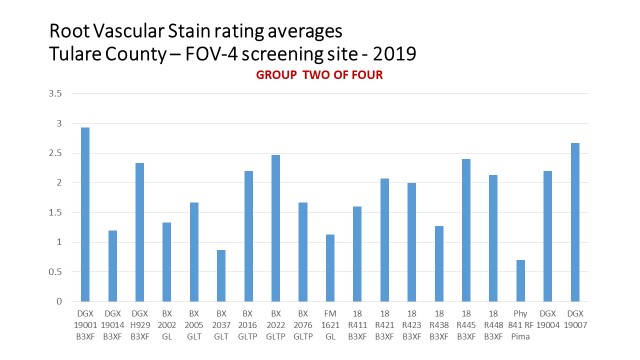
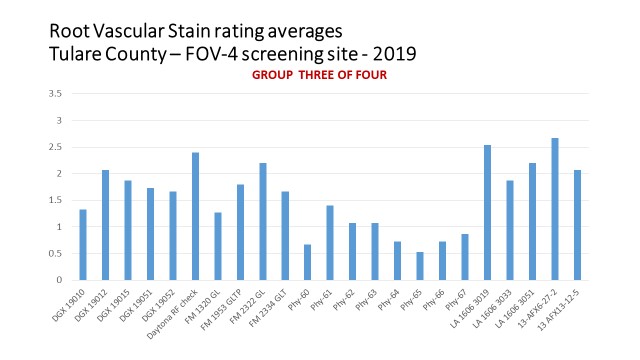
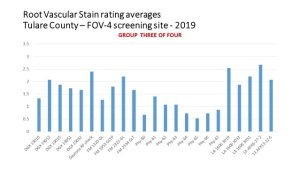
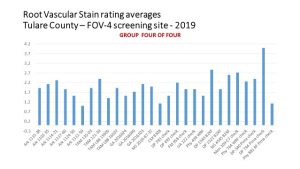
Data Summaries for 2018
As examples of the full data sets that are provided each year as a result of this project, the following tables of this report show the summary averages for the Tipton area site (Tulare County) in 2018. Similar data will be developed and posted when 2019 results are completed. These 2018 tables and those from prior year summaries are shown on the UC cotton web site at http://cottoninfo.ucdavis.edu . This information includes foliar Fusarium ratings, root vascular stain ratings, plant height and node number as indicators of vigor. In coming weeks as data is processed, we will add the plant survival percentage for each entry, but it is not included in this summary. Data shown are determined from five plants evaluated in each of three field replications per entry. The tests include all entries in University of CA cotton variety trials, additional commercial germplasm (company selected varieties plus experimentals they submitted) plus entries from the Regional Public Breeders testing program (including check varieties, organized nationally by Dr. Ted Wallace of Mississippi).
Information to focus on in reviewing the tables as best indicators of overall responses to FOV-4 infection are: (a) root vascular stain index; and (b) survival percent at 7 weeks, since they indicate relative severity of infection and impacts on plant mortality (this data, as mentioned above, is not summarized and available at this time).
“Check” varieties that are moderately to highly susceptible include: Phy-725RF, DP-340 (moderate), while a quite tolerant check variety would be Phy-802RF. The scale for Foliar FOV index and root vascular stain index ratings is 0 to 5, with 0 being no symptoms, 5 being severe (usually reserved for dead, near-dead plants). Keep in mind that ratings are done at 7+ weeks post emergence, so they are done on plants surviving at the time of the rating, which in the most severely impacted entries can be some of the few survivor plants, with most others dead. It is recommended that the combination of lower vascular stain ratings as a relative indicator of disease severity in tested plants must be considered in combination with survival of the plants in order to assess relative levels of resistance.











